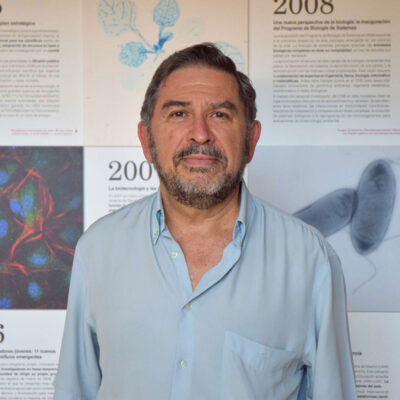Electron Microscopy under cryogenic temperatures is currently the fastest growing area in structural biology. Advances in instrumentation and software have made it possible for cryoEM to quite sustainably achieve resolutions in the order of 3Å or better for a wide range of biological specimens, without the need of crystallization or large scale protein production. I will review the bases on which this technological revolution has started, where we are now and discuss about the future ahead of us.
Cryogenic electron microscopy is revolutionizing biology: where are we now and the future ahead of us
—
Abstract
Speaker
Prof. Jose Maria Carazo Garcia
Spanish National Center for Biotechnology (CNB)
About
Jose Maria Carazo Garcia (h factor = 59, 12861 citations (ISI Web of Science-July 05, 2024), h factor = 72, 18946 (Google Scholar, July 05, 2024))), born in 1959, studied Physics at University of Granada, Spain, and obtained his PhD in Biology at University Autonoma, Madrid, Spain (1984). After the post-doc period at Wadsworth Center of the NYS Department of Health (USA) with Nobel Laureate Prof. Joachim Frank, he joined the National Center of Biotechnology as head of the Biocomputing Unit in 1989, where he was appointed full professor of the Spanish National Research Council (CSIC) in 2005.
Professor Carazo has a sustained experience in the field of Three-dimensional Electron Microscopy under cryogenic conditions (cryo-EM), especially in the methods development area. His laboratory has opened whole new areas in the field, naming just as example the successful family of Maximum Likelihood algorithms (developed in Madrid from 2007 to 2011) or the very much used EMDataBank (started from the European Union project “Bioimage” that he Coordinated from 1996 to 1999). At the level of software developments, his laboratory develops and support software packages like Xmipp and Scipion, who are been actively used by more than 1700 users in more than 13000 projects distributed throughout the world, as well as web services, like 3DBionotes, with close than 1600 new users just in 2022. Note that a specific version of Scipion developed for cryoEM facilities is currently being at the heart of some key resources, such as the European Synchrotron (ESRF), in Grenoble, and SciLab and soon the French Synchrotron Soleil.
On the technology transfer area, he founded the spin-off “Integromics”, winner of the first National Prize of La Caixa Emprendedor XXI (2007) and the Frost & Sullivan award to the Most Innovative Bioinformatics Company in Europe (2008). Integromics was acquired by the US multinational Perkin-Elmer in 2014.
He has supervised and co-supervised almost 30 postdocs and 90 graduate students. Some of them have already become key scientists in their own right, such as Sjors Scheres, who is currently at the LMB-MRC. Others have held influential positions in the private sector, such as Alberto Pascual, who serves as Product Portfolio Leader for Signals Workflows at Revvity Signals, and Carlos Oscar Sorzano, who is Co-PI of the Biocomputing Unit located at the National Center for Biotechnology – CSIC.
Selected recent publications
RSVP to this event
About
The Biophysics in Africa Monthly Colloquium Series is a joint project of the African Light Source Foundation (AfLS), African Physical Society (AfPS), and the South African Institute of Physics (SAIP). SAIP is an adhering body of the International Union of Pure and Applied Biophysics (IUPAB). The colloquia are always on the last Wednesday of every month. In addition to participation by students and colleagues worldwide, we invite speakers from around the globe as well. For more information please feel free to contact us at colloquium.series@africanbiophysics.org

